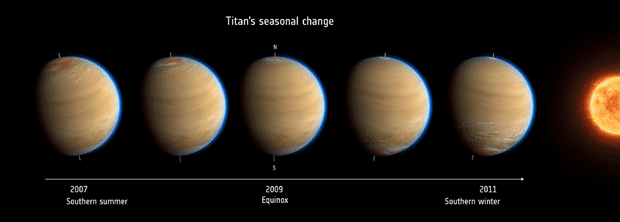
Earth’s seasons are well understood and are the result of the inclination of the planet’s axis of rotation. The North Pole points towards the Sun in the northern hemisphere summer and therefore receives more light and heat, while in winter it points away from the Sun.
Earth’s tilt is also the reason for the atmospheric circulation in the Tropics, a phenomenon that goes by the name of Hadley cells. The Sun is virtually at its zenith all year round in tropical regions, warming moist upwelling air that drives storms. When it reaches the tropopause, this air stops rising and is forced poleward by the constant flow of rising air from beneath. As it gets further from the equator, the air cools, sinks and then warms again as the prevailing winds push it back towards the equator, where the cycle starts all over again. And although it does experience variations, the overall pattern of Earth’s atmospheric circulation remains constant throughout the year.
Because it is so far away, the Saturnian system takes about 29½ years to complete its orbit of the Sun. As a result, each season on Saturn’s moon Titan lasts about 7½ Earth years. We would therefore expect any seasonal changes to be slow. But when the CIRS instrument (Composite InfraRed Spectrometer) on the NASA/ESA Cassini spacecraft was pointed at Titan from August 2009—during its equinox—scientists saw rapid changes in temperature and atmospheric composition in the moon’s upper and middle atmosphere over a period of just 6 months, the equivalent of barely 12 Titan days.
Just like Earth, Saturn is tilted with respect to its orbital plane, at an angle of approximately 27°. As Titan orbits Saturn’s equatorial plane, it also has seasons. “While Titan’s north pole was pointing towards the Sun, ultraviolet radiation and high-energy particles from our star were triggering reactions in its upper atmosphere that increased abundances of gaseous elements like hydrocarbons and nitriles at the north pole, but after the equinox and the circulation reversal, we start seeing molecules at the south pole” says Athéna Coustenis. This is because on Titan there is only one giant Hadley cell in the upper atmosphere in which warm gases upwelling at the summer pole flow directly to the winter pole and then sink, a phenomenon that is reversed at each change of season.
CIRS has found elements like cyanoacetylene (HC3N) in the haze at Titan’s south pole—currently in winter—in increasing concentrations. The slow cooling of the polar atmosphere in winter on Titan generates a vortex that pulls these elements down into the middle atmosphere, where they accumulate. This phenomenon is accompanied by a local warming of the middle atmosphere also detected by CIRS, due to adiabatic compression. As air cools at high altitude, it sinks and is concentrated at middle altitudes, causing pressure and temperature to rise.
These observations at Titan’s south pole therefore confirm its atmospheric circulation model and are the first direct evidence of an atmospheric reversal and a seasonal shift. They would not have been possible without Cassini, since Titan’s winter pole is not visible from Earth. The spacecraft is thus providing new insights into the complex atmospheric system of this Saturnian moon, while also supplying a new model to compare with models for Earth and extrasolar planets.
Article references
Nicholas A. Teanby1, Patrick G. J. Irwin2, Conor A. Nixon3, Remco de Kok4, Sandrine Vinatier5, Athena Coustenis5, Elliot Sefton-Nash1,6, Simon B. Calcutt2 and F. Michael Flasar3, Active upper-atmosphere chemistry and dynamics from polar circulation reversal on Titan, Nature, 491, 732-735, 2012.
1School of Earth Sciences, University of Bristol, Wills Memorial Building, Queen’s Road, Bristol BS8 1RJ, UK
2Atmospheric, Oceanic and Planetary Physics, Department of Physics, University of Oxford, Clarendon Laboratory, Parks Road, Oxford OX1 3PU, UK
3Planetary Systems Laboratory, NASA Goddard Space Flight Center, Greenbelt, Maryland 20771, USA
4SRON Netherlands Institute for Space Research, Sorbonnelaan 2, 3584 CA Utrecht, The Netherlands
5LESIA Observatoire de Paris, CNRS, UPMC Université Paris 06, Université Paris-Diderot, 5 place Jules Janssen, 92195 Meudon Cedex, France
6Department of Earth and Space Sciences, University of California Los Angeles, Los Angeles, California 90095-1567, USA